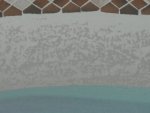Hey folks....here's my problem and I could use your help.
Last April I had my pool re plastered with 100% quartz/sand mix. Not long after we started to notice a stain or mottled pattern showing up on the entire pool surface, not just in localized areas. My water has been perfectly balanced since the re plaster. I now find myself in an uncomfortable battle with the contractor who refuses to take 100% responsibility. The water has been tested for metals, there are none and now he wants to try a full pool acid wash....lower the pH and run a circulating pump for a few days. I'm not convinced this will do much.
I have done some reading which indicates the real problem may be moisture trapped behind the plaster due to poor curing or bad mix. The contractor refuses to believe this is possible.
Please take a look at my picture which was taken on the steps in shallow end but indicative of the entire surface, and give me your thoughts. Anyone else had this problem?
Thanks so much. I have been using this forum for maintenance since the re plaster last spring and my water has never looked better. Here are my numbers:
FC 5
pH 7.6
TA 100
CH 500+ (through the roof)
CYA 50
Borate 50
Also, I have been using acid like crazy since April. I understand it's normal for new plaster but it's been over 6 months now and still using lots to keep pH down.
Last April I had my pool re plastered with 100% quartz/sand mix. Not long after we started to notice a stain or mottled pattern showing up on the entire pool surface, not just in localized areas. My water has been perfectly balanced since the re plaster. I now find myself in an uncomfortable battle with the contractor who refuses to take 100% responsibility. The water has been tested for metals, there are none and now he wants to try a full pool acid wash....lower the pH and run a circulating pump for a few days. I'm not convinced this will do much.
I have done some reading which indicates the real problem may be moisture trapped behind the plaster due to poor curing or bad mix. The contractor refuses to believe this is possible.
Please take a look at my picture which was taken on the steps in shallow end but indicative of the entire surface, and give me your thoughts. Anyone else had this problem?
Thanks so much. I have been using this forum for maintenance since the re plaster last spring and my water has never looked better. Here are my numbers:
FC 5
pH 7.6
TA 100
CH 500+ (through the roof)
CYA 50
Borate 50
Also, I have been using acid like crazy since April. I understand it's normal for new plaster but it's been over 6 months now and still using lots to keep pH down.




